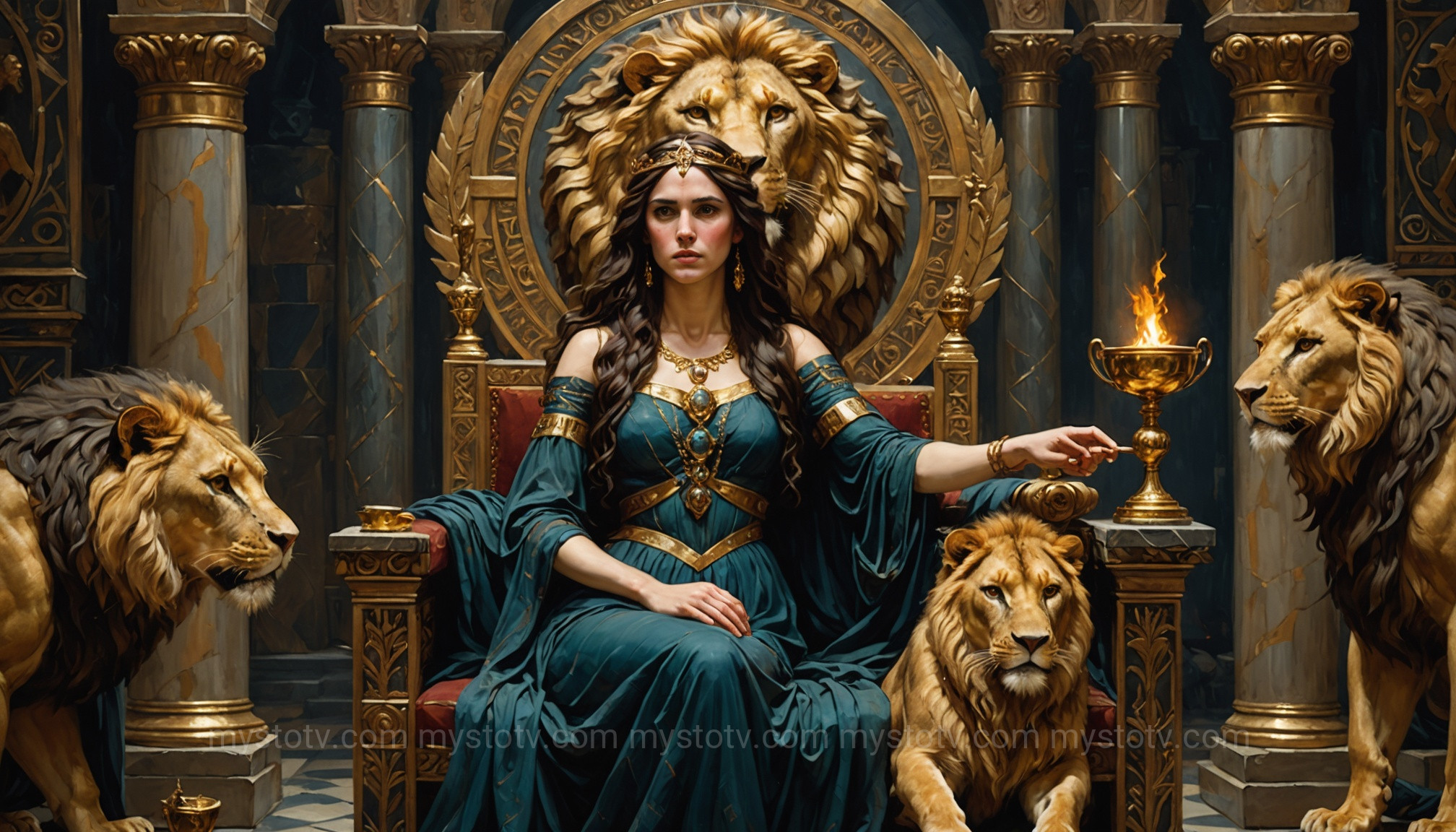I first encountered Circe in a dusty high school copy of *The Odyssey*. She was a footnote, a dangerous obstacle on a man’s journey home. She turned his crew into pigs, seduced him, and then, almost as an afterthought, helped him. The narrative moved on, but she stayed with me. There was an untold story there, a flicker of immense power and solitude that the epic poem only hinted at. Years later, reading Madeline Miller's novel, that flicker became a fire. It was a revelation, transforming a peripheral character into a protagonist of immense depth and resilience. This evolution from a mythological challenge to a modern feminist icon is the heart of the powerful circe goddess story, a tale that has found new, vibrant life in our contemporary consciousness.
Contents
- 1 Unveiling the Original Circe Goddess Story in Homer's Odyssey
- 2 Deconstructing the Ambiguity of the Circe Goddess Story
- 3 The Rebirth of the Circe Goddess Story in Modern Retellings
- 4 The Enduring Legacy of the Circe Goddess Story Today
- 5 Frequently Asked Questions about the Circe Goddess Story
- 6 References
Unveiling the Original Circe Goddess Story in Homer's Odyssey

In Homer's epic, the foundation of the circe goddess story is laid. She is not the main character, but a formidable force that the hero, Odysseus, must confront and overcome. Her introduction is steeped in dread and mystery. When Odysseus’s scouting party arrives at her palace on the island of Aiaia, they find a strangely peaceful scene with tamed lions and wolves, former men enchanted by her magic. This initial encounter establishes her absolute dominion over her realm.
The Witch of Aiaia: Power and Peril in the Circe Goddess Story
Circe is introduced as a "dread goddess with a human voice," a description that immediately captures her duality. She is the daughter of Helios, the sun Titan, and the nymph Perse. This lineage grants her divine power, but she lives in exile, honing her skills in pharmaka—the magical arts of potions, herbs, and spells. Her most infamous act is turning Odysseus's men into swine after luring them in with a feast and drugged wine. This act is a stark display of her power and a terrifying warning against her perceived treachery. The transformation is not just physical; it strips the men of their human reason, leaving them with the "minds of pigs," imprisoned in their animal forms. This part of the Circe goddess story solidifies her initial role as a dangerous antagonist.
The analysis of this episode often points to ancient Greek anxieties about unrestrained female power and sexuality. Circe, living alone and wielding immense power without a male authority figure, represents a subversion of the patriarchal order. Her magic, which targets men's gluttony and lack of caution, could be interpreted as a cautionary tale: a warning to men about the dangers of seductive, powerful women who operate outside societal norms.
From Antagonist to Ally: The Transformation Within the Circe Goddess Story
The narrative shifts dramatically with Odysseus's arrival. Forewarned by the god Hermes, Odysseus resists Circe’s potion with a magical herb, Moly. He overpowers her, and rather than destroying her, forces her to swear an oath not to harm him. This confrontation leads to an unexpected turn in the circe goddess story. She reverses her spell on his men and becomes his lover and hostess for an entire year. Her palace transforms from a prison into a sanctuary of respite and pleasure.
More importantly, Circe evolves from a threat into a crucial guide. When Odysseus must continue his journey, she provides him with the essential knowledge he needs to navigate the treacherous path ahead. She gives him precise instructions on how to reach the Underworld, how to consult the seer Tiresias, and how to survive the Sirens, Scylla, and Charybdis. Without Circe's aid, Odysseus's quest would have failed. This transformation from a fearsome witch to a wise benefactor adds a layer of complexity to her character, suggesting she is more than just a simple villain. Her power, once used for punishment, is now used for guidance and protection, revealing a capacity for wisdom and alliance.
Deconstructing the Ambiguity of the Circe Goddess Story
The true power of the circe goddess story lies in its profound ambiguity. For centuries, readers and scholars have debated her nature. Is she a monstrous witch or a misunderstood goddess? A symbol of dangerous female sexuality or a figure of self-sufficient autonomy? The answer is not simple, and this complexity is what makes her so eternally fascinating. Her narrative is a rich ground for interpretation, reflecting the cultural values of those who tell and retell her tale.
A Symbol of Female Autonomy or a Cautionary Tale?
Viewed through one lens, the original circe goddess story is a cautionary tale. She is a powerful woman living in isolation, whose magic emasculates men by turning them into beasts. Her power is only neutralized when a male hero, with divine aid, confronts and "tames" her. In this interpretation, she represents a threat to the heroic, patriarchal world, and her eventual submission to Odysseus restores the proper order. Her year-long affair with him and her subsequent help can be seen as her assimilation into a more acceptable, subservient female role—the helper and lover of the male hero.
However, a more modern, feminist reading of the circe goddess story offers a different perspective. Circe is a single woman who is entirely self-sufficient. She is a goddess, a landowner, a powerful practitioner of her craft, and sexually liberated. She owes allegiance to no one. The men who arrive on her island are invaders who, in some interpretations, attempt to assault her, and her magic is a form of self-defense. By turning them into pigs, she is merely revealing their true, bestial nature. From this viewpoint, she is a powerful figure of female autonomy who defends her home and her personhood against unwelcome intruders.
The Power of Pharmaka: Witchcraft, Knowledge, and Healing in the Circe Goddess Story

Central to the circe goddess story is her mastery of pharmaka. This Greek word is wonderfully ambiguous, meaning not just "poison" but also "drug," "remedy," and "spell." Her power isn't merely destructive witchcraft; it is a deep, almost scientific knowledge of botany and chemistry. She understands the hidden properties of the natural world and knows how to manipulate them to her will. This knowledge is her power, a craft she has honed over centuries of solitary study on Aiaia.
Her use of pharmaka is what makes her both feared and respected. She can use it to transform men into animals, but she can also use it to create the antidote. She uses it to protect Odysseus from the Sirens by telling him to plug his men's ears with beeswax. Her knowledge is a double-edged sword, representing the immense power that comes from understanding the fundamental, often hidden, laws of nature. It's a form of power that is distinct from the brute strength of male heroes and gods, rooted instead in wisdom, patience, and intellect.
The Rebirth of the Circe Goddess Story in Modern Retellings
For millennia, the circe goddess story was told from the outside, primarily through the eyes of the men who encountered her. She was an episode, a chapter in someone else's epic. The 21st century, however, has seen a powerful resurgence of interest in her character, driven by a desire to reclaim forgotten or silenced female voices from history and mythology. This has led to a complete re-framing of her narrative, transforming her into a complex, relatable protagonist in her own right.
Madeline Miller's Circe: Giving a Voice to the Voiceless in the Circe Goddess Story

The single most significant catalyst for Circe’s modern revival is Madeline Miller’s bestselling 2018 novel, *Circe*. Miller takes the brief sketch from *The Odyssey* and expands it into a sweeping, epic life story told entirely from Circe’s perspective. This novel fundamentally changed the modern understanding of the circe goddess story by giving her a voice, a history, and a motivation.
In Miller's hands, Circe is born the "dullest of daughters" to the mighty Helios. Scorned by her divine family for her lack of dazzling power and her strange, mortal-like empathy, she discovers her talent for pharmaka out of desperation and loneliness. Her exile to Aiaia is not just a punishment but also a liberation, allowing her to develop her skills and identity far from the cruel politics of the gods. Miller's novel delves into her trauma—particularly the horrific experiences with sailors who see her island as ripe for plunder and her as a woman to be violated. The transformation of men into pigs is recast not as an act of arbitrary cruelty, but as a desperate, righteous act of self-preservation. This re-framing provides a stark contrast to her original portrayal, giving her actions a powerful and relatable justification.
Circe as a Feminist Icon: Embracing Power and Resilience in the Circe Goddess Story
Madeline Miller’s novel cemented Circe's status as a modern feminist icon. Her story resonates deeply with contemporary conversations about female empowerment, trauma, and self-definition. The modern circe goddess story is one of a woman who is consistently underestimated and ostracized but who, through intellect, hard work, and sheer will, forges her own power. She learns that the things others mocked her for—her "mortal" voice, her empathy, her interest in the earth—are the very sources of her unique strength.
She is an icon of resilience. She endures the scorn of her family, the violence of men, the loneliness of exile, and the heartbreak of loving mortals. Yet, she does not break. Instead, she grows, learns, and defines herself on her own terms. Ultimately, her greatest act of power is choosing her own destiny—rejecting the empty immortality of the gods for a mortal life filled with meaning, love, and choice. This arc makes her a compelling symbol for anyone who has ever felt like an outsider and had to fight to create their own place in the world.
The Enduring Legacy of the Circe Goddess Story Today
The impact of the revitalized circe goddess story extends far beyond a single novel. Her journey from a mythological footnote to a cultural touchstone demonstrates her timeless relevance. She has been embraced as a symbol of female creativity, knowledge, and defiance, proving that the stories we choose to retell say as much about us as they do about their original subjects. Her legacy is one of transformation—both her own and ours.
From Art and Literature to Pop Culture
While Miller's novel is the most prominent example, Circe has been a muse for centuries. She has been depicted in countless paintings, from the pre-Raphaelite visions of John William Waterhouse to modern interpretations. She appears in poetry, theater, and other literary works that explore the "witch" archetype. In contemporary pop culture, her influence can be seen in characters who embody the powerful, independent sorceress archetype—women who live by their own rules and command respect through their knowledge and skill. The modern circe goddess story provides a rich template for complex female characters who are neither purely good nor purely evil.
Why the Circe Goddess Story Still Captivates Us
Ultimately, the circe goddess story endures because it speaks to fundamental human themes. It is a story about finding power in solitude, the transformative potential of knowledge, and the courage to define one's own identity against the expectations of others. Circe embodies the struggle to turn one's weaknesses into strengths and one's exile into a kingdom.
She teaches us that power doesn't have to be loud or aggressive; it can be quiet, patient, and rooted in wisdom. Her story challenges us to look beyond simplistic labels of "good" and "evil," "witch" and "goddess," and to appreciate the complex, often contradictory, nature of identity. In an age where many are seeking to reclaim their narratives and find strength in their own voices, the tale of the goddess who learned to sing her own song is more powerful than ever.
Frequently Asked Questions about the Circe Goddess Story
The renewed interest in the circe goddess story has led to many questions about her character and mythology. Here are answers to some of the most common queries.
1. Was Circe a goddess, a witch, or a nymph?
Technically, all three. By birth, she was a goddess, the daughter of the Titan sun god Helios and the Oceanid nymph Perse. This divine parentage gave her immortal life and innate potential. However, the term "witch" (or sorceress) accurately describes what she does—she practices pharmaka (magic). Unlike gods like Zeus or Apollo whose power is inherent and often demonstrated through brute force or divine authority, Circe's power is a craft she has to learn and perfect. So, she is a goddess by nature and a witch by practice and reputation.
2. What happened to Circe after the Odyssey?
Ancient traditions vary, but a key post-Odyssey myth involves Telegonus, her son by Odysseus. In the *Telegony*, a lost epic that followed *The Odyssey*, a grown Telegonus sets out to find his father. He lands on Ithaca and, not recognizing Odysseus, kills him in a battle. A grief-stricken Telegonus brings Odysseus's body back to Aiaia, along with Penelope and Telemachus. In a strange turn of events, Circe makes them all immortal, and she eventually marries Telemachus while Telegonus marries Penelope. Madeline Miller's novel offers a different, more modern ending where Circe makes a profound choice about her own immortality.
3. What does Circe turning men into pigs symbolize?
This is one of the most analyzed parts of the circe goddess story. The symbolism is multi-layered. On a basic level, it's a punishment for the men's gluttony and lack of self-control; they behave like pigs at her table, so she makes their outsides match their insides. On a deeper level, it represents a profound fear of female power—the ability of a woman to emasculate men and strip them of their humanity and reason. In more recent interpretations, it is seen as an act of justice or self-defense, a way for Circe to reveal the bestial nature of men who view her with lust and contempt.
References
- Homer. The Odyssey. Translated by Emily Wilson, W. W. Norton & Company, 2018. https://wwnorton.com/books/9780393356250
- Miller, Madeline. Circe. Little, Brown and Company, 2018. https://www.littlebrown.com/titles/madeline-miller/circe/9780316556347/
The journey of the circe goddess story from a minor episode in an ancient epic to a central text of modern feminist literature is nothing short of extraordinary. She has been transformed from a one-dimensional obstacle into a multifaceted symbol of resilience, knowledge, and self-defined power. Whether viewed as the fearsome witch of Aiaia or the resilient protagonist of her own life, Circe’s enduring narrative challenges us to look deeper, to question who gets to tell the story, and to find the magic in reclaiming one's own voice. Her tale is a powerful reminder that even characters left in the margins can step into the light and become icons for a new generation.